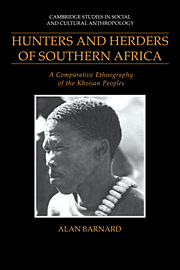Book contents
- Frontmatter
- Contents
- List of figures and maps
- List of tables
- Preface
- A note on orthography
- Part I The Khoisan peoples
- Part II A survey of Khoisan ethnography
- Part III Comparisons and transformations
- 12 Settlement and territoriality among the desert-dwelling Bushmen
- 13 Politics and exchange in Khoisan society
- 14 Aspects of Khoisan religious ideology
- 15 Bushman kinship: correspondences and differences
- 16 Khoe kinship: underlying structures and transformations
- 17 Conclusions
- References
- Index
- Cambridge Studies in Social and Cultural Anthropology
12 - Settlement and territoriality among the desert-dwelling Bushmen
Published online by Cambridge University Press: 05 June 2012
- Frontmatter
- Contents
- List of figures and maps
- List of tables
- Preface
- A note on orthography
- Part I The Khoisan peoples
- Part II A survey of Khoisan ethnography
- Part III Comparisons and transformations
- 12 Settlement and territoriality among the desert-dwelling Bushmen
- 13 Politics and exchange in Khoisan society
- 14 Aspects of Khoisan religious ideology
- 15 Bushman kinship: correspondences and differences
- 16 Khoe kinship: underlying structures and transformations
- 17 Conclusions
- References
- Index
- Cambridge Studies in Social and Cultural Anthropology
Summary
Introduction
Bushman settlement and territoriality have been subjects of much discussion over the years (see, e.g., Heinz 1972; 1979; Barnard 1979a; 1986a; 1991; Guenther 1981b; Cashdan 1983). Authors have approached the problem from a number of different perspectives. My early work on Kalahari Bushman settlement patterns (Barnard 1979a) was partly inspired by Hoernlé's ‘South West Africa as a primitive culture area’ (1923a), in which she argued that the distribution of water resources was an important determinant of Nama tribal and territorial organization. Here, I shall be reexamining Hoernlé's suggestion in relation to more recent work on the Kalahari Bushman peoples and some relevant theoretical ideas. The present chapter focuses not primarily on the actual ethnographic details of settlement and territoriality, which are summarized in earlier chapters, but on models derived from a comparative approach to the data.
The groups to be discussed include the four ethnic divisions of primary concern in earlier papers by Elizabeth Cashdan (1983) and me (Barnard 1979a; 1986a) – namely the Zu/'hoãsi, or Central !Kung; the G/wi and G//ana, treated together as the ‘Central Kalahari Bushmen’; the Nharo; and the !Xõ. For some purposes (since Cashdan 1984a; 1984b) it is now useful to distinguish the two groups occupying the Central Kalahari Game Reserve as distinct peoples with different settlement patterns – specifically the G/wi, as studied by Silberbauer in the early 1960s, and the G//ana, as studied by Cashdan in the late 1970s.
- Type
- Chapter
- Information
- Hunters and Herders of Southern AfricaA Comparative Ethnography of the Khoisan Peoples, pp. 223 - 236Publisher: Cambridge University PressPrint publication year: 1992



